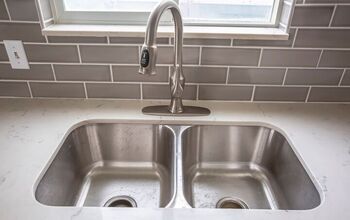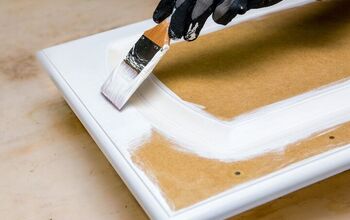What Is A Toe Kick For Cabinets? (Find Out Now!)

Many people wonder about that space on the bottom of their kitchen cabinets. That space that is hard to clean, dark, and often overlooked. Many people don’t realize that nook under your kitchen cabinets is a vital part of kitchen cabinet design. Beyond being hard to clean, the toe kick is an ergonomic feature that makes your cabinets a better place to work.
From a technical standpoint, a toe kick on kitchen cabinets is a notch-shaped recess at the bottom front of a base cabinet. As the name implies, this notched area allows you to stand with your body flush against the cabinet. The notch provides a place for your toes without having to twist your ankles at an uncomfortable angle.
Without a toe kick, you would find yourself standing well back from the front edge of your kitchen cabinets. This position puts you are an awkward distance to work easily at your cabinet, not to mention using the sink for washing and rinsing. Without this ergonomic addition to your kitchen cabinets, working in your kitchen could become a painful situation.
Do You Need to Hire Cabinet Installers?
Get free, zero-commitment quotes from pro contractors near you.

The Ergonomics of Kitchen Work
It might surprise you that there is a lot of research about kitchen design and kitchen tasks. Kitchen design has become a science, with almost every facet of best design a kitchen being studied. The toe kick is almost as old as kitchen cabinets. Early on, cabinet builders learned that housewives complained less about working in the kitchen by adding a small recess under the front edge of kitchen cabinets.
Most of the time anyone spends in a kitchen is standing. Kitchen countertops are essentially workspaces. The typical countertop is about twenty-four inches from front to back. This is also about the best distance for working reach when standing at a kitchen cabinet.
Without a toe kick, anyone working at a kitchen cabinet would be forced to stand six to eight inches further away from the edge of the countertop. This extra four to eight inches also puts the back of the countertop just out of reach for most people. This can lead to uncomfortable positions or overextension that can cause back and leg pain for some people.
A toe kick eliminates these awkward positions or possible over-extension and makes your kitchen a more efficient and enjoyable place to work and cook.
Toe Kicks Versus Cabinet Legs
Many kitchen designs opt for installing legs instead of a toe kick on lower cabinets. There are several reasons for choosing legs over a toe kick.
Easier Cleaning in Some Situations
Cabinet legs instead of a toe kick have long been the choice in commercial kitchens. The concept is now making its way into home kitchen designs. In commercial kitchens, cleanliness is the number one objective. Raising workspaces up on legs allows the entire area under the workspace to be cleaned easily and effectively.
In some home kitchens, cabinet areas that support an island countertop benefit from this same concept. Cabinets sitting on legs offer easier access to clean the floor space under the counter. However, putting cabinets mounted along a wall on legs can create more problems than its solves. In this instance, keeping the area close to the wall clean can become a problem.
Unlevel Floors
If your kitchen suffers from unlevel floors, a te kick can make installation difficult. The toe kick supports the cabinet along its entire length. High low spots on the kitchen floor can make leveling a kitchen cabinet with a toe kick difficult.
Most legs used on kitchen cabinets include screw-type levelers that make overcoming these issues much easier. The levelers can simply be lowered or raised to compensate for unevenness in the floors. In older houses where some floor movement may continue, the cabinets can be easily adjusted over time to compensate for the floor movement.
Toe Kicks Versus Furniture Bases
In many newer homes, builders and homeowners choose a cabinet base profile that more resembles furniture than traditional cabinets. This type of design eliminates the toe kick on cabinets and brings the edges of the cabinets to the floor. In most cases, the cabinet base is trimmed to look like traditional furniture rather than a cabinet.
For the most part, this is a design feature of custom-built and installed cabinets rather than factory-built cabinets. These custom-built cabinets are usually a part of an overall interior design plan and feature in many custom-built homes.
Are Toe Kicks required By Building Codes?
We know of no building code that requires toe kicks to be a part of a kitchen design. Adding toe kicks to kitchen cabinets is a traditional concept that most cabinet builders follow. There are some differences in designs that often mimic a furniture look but include a toe kick.
Toe kick dimensions are also traditionally 3 tp 3 ½ inches deep and high. These dimensions can vary depending on homeowner preference and needs. Consult with your home builder or cabinet maker for options on the dimensions of the toe kick on your cabinets.
Toe Kicks Seem Like Wasted Space
Many kitchen designers agree. If you search, you can find many accessories that fit into your toe kick space to make it more useable. The most popular way to use the space in a toe kick is to install slide-out drawers. These types of drawers typically ride on rollers rather than traditional drawer slides.
One unique accessory we have seen that utilizes toe kick space is a folding step stool that stores in the space under the cabinet. The step stool can be pulled out, unfolded, and used to access overhead cabinets. This is especially useful where overhead cabinets reach the ceiling instead of a dropdown.
A good custom cabinet builder may be able to create almost any kind of accessory to hide behind a toe kick. Remember that accessing these hidden storage areas may be difficult since the fronts will be recessed three inches under the face of the cabinet.
Do You Need to Hire Cabinet Installers?
Get free, zero-commitment quotes from pro contractors near you.

The Lowly Toe Kick
That hidden area recessed beneath the front of your cabinet is often overlooked. However, it performs a vital function in some cases to make your kitchen more functional. Your comfort while working in your kitchen may well depend on that forgotten space.

Dennis is a retired firefighter with an extensive background in construction, home improvement, and remodeling. He worked in the trades part-time while serving as an active firefighter. On his retirement, he started a remodeling and home repair business, which he ran for several years.
More by Dennis Howard



























